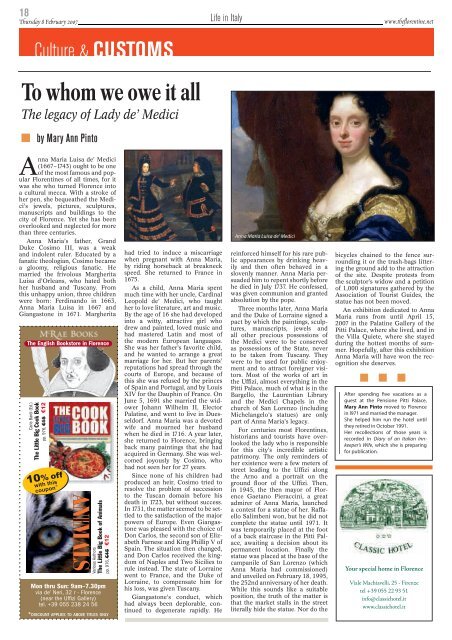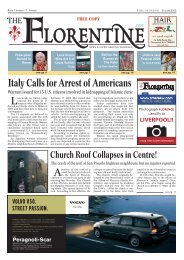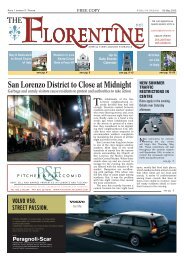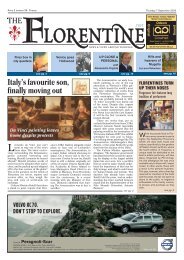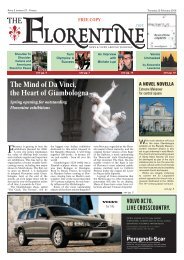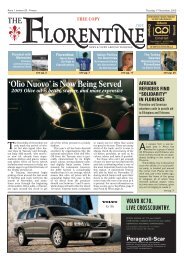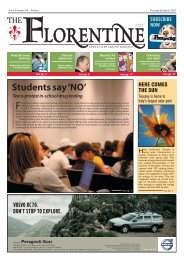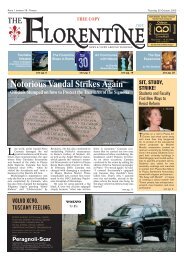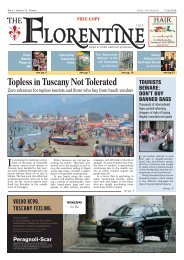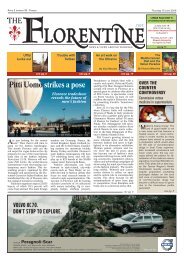Without the Arno, Florence would be like Romolo - The Florentine
Without the Arno, Florence would be like Romolo - The Florentine
Without the Arno, Florence would be like Romolo - The Florentine
Create successful ePaper yourself
Turn your PDF publications into a flip-book with our unique Google optimized e-Paper software.
18<br />
Thursday 8 February 2007<br />
Culture & CUSTOMS<br />
To whom we owe it all<br />
<strong>The</strong> legacy of Lady de’ Medici<br />
Carla Bardi (Ed.)<br />
<strong>The</strong> Little Big Cook Book<br />
by Mary Ann Pinto<br />
Anna Maria Luisa de’ Medici<br />
(1667–1743) ought to <strong>be</strong> one<br />
of <strong>the</strong> most famous and popular<br />
<strong>Florentine</strong>s of all times, for it<br />
was she who turned <strong>Florence</strong> into<br />
a cultural mecca. With a stroke of<br />
her pen, she <strong>be</strong>quea<strong>the</strong>d <strong>the</strong> Medici’s<br />
jewels, pictures, sculptures,<br />
manuscripts and buildings to <strong>the</strong><br />
city of <strong>Florence</strong>. Yet she has <strong>be</strong>en<br />
overlooked and neglected for more<br />
than three centuries.<br />
Anna Maria’s fa<strong>the</strong>r, Grand<br />
Duke Cosimo III, was a weak<br />
and indolent ruler. Educated by a<br />
fanatic <strong>the</strong>ologian, Cosimo <strong>be</strong>came<br />
a gloomy, religious fanatic. He<br />
married <strong>the</strong> frivolous Margherita<br />
Luisa d’Orleans, who hated both<br />
her husband and Tuscany. From<br />
this unhappy union, three children<br />
were born: Ferdinando in 1663,<br />
Anna Maria Luisa in 1667 and<br />
Giangastone in 1671. Margherita<br />
<strong>The</strong> English Bookstore in <strong>Florence</strong><br />
pp. 976, €15 €12<br />
10% off<br />
with this<br />
coupon*<br />
ANIMALS<br />
<strong>The</strong> Little Big Book of<br />
Various Authors<br />
<strong>The</strong> Little Big Book of Animals<br />
Mon thru Sun: 9am–7.30pm<br />
via de’ Neri, 32 r - <strong>Florence</strong><br />
(near <strong>the</strong> Uffizi Gallery)<br />
tel. +39 055 238 24 56<br />
pp. 976, €15 €12<br />
*DISCOUNT APPLIES TO ABOVE TITLES ONLY<br />
had tried to induce a miscarriage<br />
when pregnant with Anna Maria,<br />
by riding horseback at breakneck<br />
speed. She returned to France in<br />
1675.<br />
As a child, Anna Maria spent<br />
much time with her uncle, Cardinal<br />
Leopold de’ Medici, who taught<br />
her to love literature, art and music.<br />
By <strong>the</strong> age of 16 she had developed<br />
into a witty, attractive girl who<br />
drew and painted, loved music and<br />
had mastered Latin and most of<br />
<strong>the</strong> modern European languages.<br />
She was her fa<strong>the</strong>r’s favorite child,<br />
and he wanted to arrange a great<br />
marriage for her. But her parents’<br />
reputations had spread through <strong>the</strong><br />
courts of Europe, and <strong>be</strong>cause of<br />
this she was refused by <strong>the</strong> princes<br />
of Spain and Portugal, and by Louis<br />
XIV for <strong>the</strong> Dauphin of France. On<br />
June 5, 1691 she married <strong>the</strong> widower<br />
Johann Wilhelm II, Elector<br />
Palatine, and went to live in Duesseldorf.<br />
Anna Maria was a devoted<br />
wife and mourned her husband<br />
when he died in 1716. A year later,<br />
she returned to <strong>Florence</strong>, bringing<br />
back many paintings that she had<br />
acquired in Germany. She was welcomed<br />
joyously by Cosimo, who<br />
had not seen her for 27 years.<br />
Since none of his children had<br />
produced an heir, Cosimo tried to<br />
resolve <strong>the</strong> problem of succession<br />
to <strong>the</strong> Tuscan domain <strong>be</strong>fore his<br />
death in 1723, but without success.<br />
In 1731, <strong>the</strong> matter seemed to <strong>be</strong> settled<br />
to <strong>the</strong> satisfaction of <strong>the</strong> major<br />
powers of Europe. Even Giangastone<br />
was pleased with <strong>the</strong> choice of<br />
Don Carlos, <strong>the</strong> second son of Eliza<strong>be</strong>th<br />
Farnese and King Phillip V of<br />
Spain. <strong>The</strong> situation <strong>the</strong>n changed,<br />
and Don Carlos received <strong>the</strong> kingdom<br />
of Naples and Two Sicilies to<br />
rule instead. <strong>The</strong> state of Lorraine<br />
went to France, and <strong>the</strong> Duke of<br />
Lorraine, to compensate him for<br />
his loss, was given Tuscany.<br />
Giangastone’s conduct, which<br />
had always <strong>be</strong>en deplorable, continued<br />
to degenerate rapidly. He<br />
Life in Italy<br />
Anna Maria Luisa de’ Medici<br />
reinforced himself for his rare public<br />
appearances by drinking heavily<br />
and <strong>the</strong>n often <strong>be</strong>haved in a<br />
slovenly manner. Anna Maria persuaded<br />
him to repent shortly <strong>be</strong>fore<br />
he died in July 1737. He confessed,<br />
was given communion and granted<br />
absolution by <strong>the</strong> pope.<br />
Three months later, Anna Maria<br />
and <strong>the</strong> Duke of Lorraine signed a<br />
pact by which <strong>the</strong> paintings, sculptures,<br />
manuscripts, jewels and<br />
all o<strong>the</strong>r precious possessions of<br />
<strong>the</strong> Medici were to <strong>be</strong> conserved<br />
as possessions of <strong>the</strong> State, never<br />
to <strong>be</strong> taken from Tuscany. <strong>The</strong>y<br />
were to <strong>be</strong> used for public enjoyment<br />
and to attract foreigner visitors.<br />
Most of <strong>the</strong> works of art in<br />
<strong>the</strong> Uffi zi, almost everything in <strong>the</strong><br />
Pitti Palace, much of what is in <strong>the</strong><br />
Bargello, <strong>the</strong> Laurentian Library<br />
and <strong>the</strong> Medici Chapels in <strong>the</strong><br />
church of San Lorenzo (including<br />
Michelangelo’s statues) are only<br />
part of Anna Maria’s legacy.<br />
For centuries most <strong>Florentine</strong>s,<br />
historians and tourists have overlooked<br />
<strong>the</strong> lady who is responsible<br />
for this city’s incredible artistic<br />
patrimony. <strong>The</strong> only reminders of<br />
her existence were a few meters of<br />
street leading to <strong>the</strong> Uffi zi along<br />
<strong>the</strong> <strong>Arno</strong> and a portrait on <strong>the</strong><br />
ground fl oor of <strong>the</strong> Uffi zi. <strong>The</strong>n,<br />
in 1945, <strong>the</strong> <strong>the</strong>n mayor of <strong>Florence</strong><br />
Gaetano Pieraccini, a great<br />
admirer of Anna Maria, launched<br />
a contest for a statue of her. Raffaello<br />
Salim<strong>be</strong>ni won, but he did not<br />
complete <strong>the</strong> statue until 1971. It<br />
was temporarily placed at <strong>the</strong> foot<br />
of a back staircase in <strong>the</strong> Pitti Palace,<br />
awaiting a decision about its<br />
permanent location. Finally <strong>the</strong><br />
statue was placed at <strong>the</strong> base of <strong>the</strong><br />
campanile of San Lorenzo (which<br />
Anna Maria had commissioned)<br />
and unveiled on February 18, 1995,<br />
<strong>the</strong> 252nd anniversary of her death.<br />
While this sounds <strong>like</strong> a suitable<br />
position, <strong>the</strong> truth of <strong>the</strong> matter is<br />
that <strong>the</strong> market stalls in <strong>the</strong> street<br />
literally hide <strong>the</strong> statue. Nor do <strong>the</strong><br />
www.<strong>the</strong>fl orentine.net<br />
bicycles chained to <strong>the</strong> fence surrounding<br />
it or <strong>the</strong> trash-bags littering<br />
<strong>the</strong> ground add to <strong>the</strong> attraction<br />
of <strong>the</strong> site. Despite protests from<br />
<strong>the</strong> sculptor’s widow and a petition<br />
of 1,000 signatures ga<strong>the</strong>red by <strong>the</strong><br />
Association of Tourist Guides, <strong>the</strong><br />
statue has not <strong>be</strong>en moved.<br />
An exhibition dedicated to Anna<br />
Maria runs from until April 15,<br />
2007 in <strong>the</strong> Palatine Gallery of <strong>the</strong><br />
Pitti Palace, where she lived, and in<br />
<strong>the</strong> Villa Quiete, where she stayed<br />
during <strong>the</strong> hottest months of summer.<br />
Hopefully, after this exhibition<br />
Anna Maria will have won <strong>the</strong> recognition<br />
she deserves.<br />
After spending fi ve vacations as a<br />
guest at <strong>the</strong> Pensione Pitti Palace,<br />
Mary Ann Pinto moved to <strong>Florence</strong><br />
in l971 and married <strong>the</strong> manager.<br />
She helped him run <strong>the</strong> hotel until<br />
<strong>the</strong>y retired in Octo<strong>be</strong>r 1991.<br />
Her recollections of those years is<br />
recorded in Diary of an Italian Innkeeper’s<br />
Wife, which she is preparing<br />
for publication.<br />
�����������������������������<br />
�������������������������������<br />
��������������������<br />
���������������������<br />
�������������������


